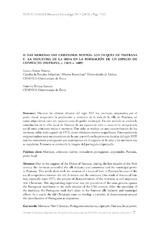Si hay moreras hay cristianos nuevos: Los Duques de Pastrana y la industria de la seda en la formación de un espacio de conflicto (Pastrana, c. 1569- c. 1609)
Autor
Bastos Mateus, Susana
Terrasa Lozano, Antonio
Editor
Universidad de Córdoba, UcoPressFecha
2015Materia
MoriscosCristianos nuevos
Mercaderes portugueses
Criptojudío
Pastrana
Poder local
New Christian
Portuguese merchants
Criptojew
Local power
METS:
Mostrar el registro METSPREMIS:
Mostrar el registro PREMISMetadatos
Mostrar el registro completo del ítemResumen
Durante las últimas décadas del siglo XVI los moriscos, amparados por el poder ducal, acapararon la producción y comercio de la seda de la villa de Pastrana, así como adquirieron cada vez mayores cotas de poder municipal. En este artículo se analiza la constitución en la villa ducal de Pastrana de un espacio de odio a causa de la competencia social entre cristianos viejos y moriscos. Este odio se tradujo en una caracterización de los moriscos, sobre todo a partir de 1572, como cristianos nuevos sospechosos. Esta experiencia estigmatizadora sería un precedente de lo que ocurriría en las primeras decadas del siglo XVII con los mercaderes portugueses que sustituyeron en el negocio de la seda a los moriscos tras su expulsión. Entonces se contruiría la imagen del portugués critptojudío. Due to the support of the Dukes of Pastrana, during the last decades of the 16th century the moriscos controlled the silk industry and commerce and the municipal power in Pastrana. This article deals with the creation of a locus of hate in Pastrana because of the social competition between the old christians and the moriscos. One result of this social hate was, especially since 1572, the process of characterization of the moriscos as evil suspicious new Christians. This stigmatizing experience was the precedent of the same process against the Portuguese merchants in the early decades of the 17th century. After the expulsion of the moriscos, the Portuguese took their place in the Pastrana silk industry and municipal offices. As a result, the old Christians came to develop a narrative of demonization around the identification of Portuguese as criptojews.

